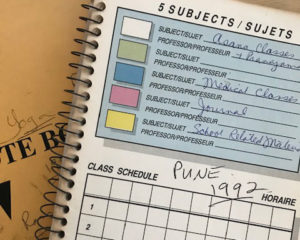Reliving teachings through our yoga journals
by Linda Shevloff
 If you spend any time with Iyengar yoga teachers, you might notice that they have a penchant for note taking, especially after workshops or certain classes. I don’t think I was much of a note-taker before I started on an Iyengar path, but certainly, once I began to study yoga more seriously, I found I needed to start writing down the highlights of lessons in order to work with these ideas after class.
If you spend any time with Iyengar yoga teachers, you might notice that they have a penchant for note taking, especially after workshops or certain classes. I don’t think I was much of a note-taker before I started on an Iyengar path, but certainly, once I began to study yoga more seriously, I found I needed to start writing down the highlights of lessons in order to work with these ideas after class.
On the yoga mat, the learning process requires concentration. There are the basics of the asanas to absorb and then there can be an almost endless stream of details about the asanas to understand. In class we learn to focus. We listen to a teacher’s instruction and sometimes follow minute instruction with singular attention. After the class is over, the goal is to retain what has been taught.
I think it was when I began teacher-training that I started making notes for myself . Mentally reviewing lessons after class helped me to recall more. First I would try to remember the sequence of what we did and then any particular instructions. Sometimes I could hardly recall anything, but I would write down what I did remember and then I would use those memories as the basis of my practice for the rest of the week.
Once I got to the stage where I was to stand in front of a class to instruct students, it became very clear to me that accurate recall was important for clear teaching. When more experienced teachers instruct, they are able to ground their teaching in what they see in the student bodies in front of them at the moment, but new teachers rely more on what they remember. As a new teacher, I had to remember the order of things, the names of things, and the reasons for things.
Now, as an older teacher, I have a sizeable collection of journals that I have kept on the topic of yoga. I find I make different kinds of notations at this time, but I still use the writing method to reinforce retention.
I lead a monthly yoga philosophy class, and ironically, we recently listened to a recording of Edwin Bryant talking about the dark era or Kaliyuga that we currently live in. In a prior age, people relied solely on their sharp memories to retain learning. They did not use the written word. Writing was a tool used later when it seemed the knowledge might become lost. Even The Yoga Sutras of Patañjali were a codified summary of yoga knowledge, inscribed out of fear that the knowledge was going to disappear.
Over the course of the past year I have gone back to some of my earlier notebooks and have been using them as the foundation of one of my classes. I have been using notebooks I wrote during trips to India to study with BKS Iyengar and his daughter Geeta starting from 1987. The notes have become somewhat precious to me now especially because both of them have passed away. They were such incredible, insightful teachers. I was just a student so of course my notes depend on the quality of my recall, but still there is a lot there and I think that the students in that current class are enjoying taking these yoga journeys back to India with me. The notes provide much more than asana and pranayama instruction. They give a little taste of the thought and insight that the Iyengars provided. They remind me of different ways we have worked with asana and how the practice has evolved over time. They help me to remember and appreciate the teachers I have had.

